The Heavens
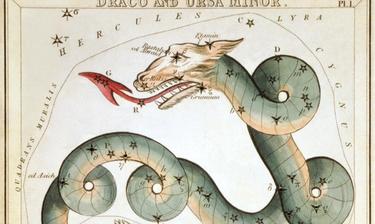
The Heavens
Draco
By Carl J. Butz
•
August 23, 2024
Explore Draco, a constellation rich in mythology and celestial bodies, visible near Vega this week.
Read More
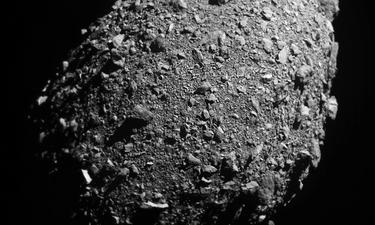
The Heavens
A Success for NASA
By Carl J. Butz
•
July 10, 2024
NASA's DART mission successfully redirected an asteroid, proving the feasibility of altering hazardous asteroid trajectories.
Read More
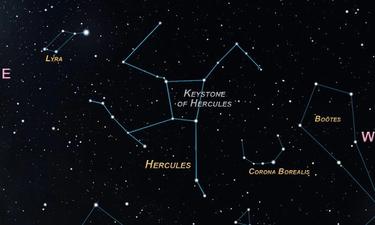
The Heavens
Hercules
By Carl J. Butz
•
June 26, 2024
The late spring and early summer months are the best time to observe the constellation named after Hercules, the mythological Roman hero famed for his strength and courage while subduing monsters, bandits, and criminals.
Read More

The Heavens
Star Wars Redux?
By Carl J. Butz
•
June 6, 2024
In 1983, George Lucas released “The Return of the Jedi,” and President Reagan proposed creating a system designed to protect the U.S. from any nuclear bombs the Soviet Union might send our way via intercontinental ballistic missiles.
Read More

The Heavens
Planets and Meteors in May
By Carl J. Butz
•
May 2, 2024
Throughout this month, Mars and Saturn will be visible in the eastern sky during early morning hours, before 05:30.
Read More
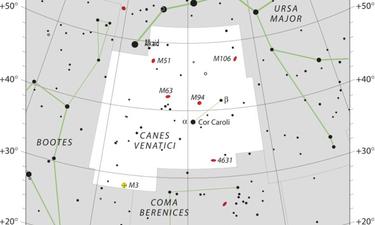
The Heavens
Canes Venatici — The Hunting Dogs
By Carl J. Butz
•
April 24, 2024
Spring is an excellent time to view the Big Dipper in the northwest sky soon after sunset.
Read More
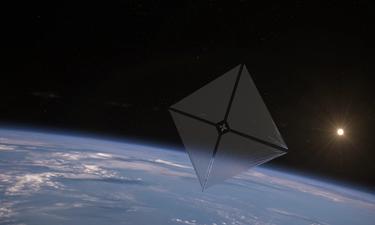
The Heavens
Solar Sailing
By Carl J. Butz
•
April 18, 2024
Once promoted by Carl Sagan to Johnny Carson on the Tonight Show, the idea of traveling through space via a reflective “sail” - powered by the momentum of photons radiating out from the sun - continues to command attention.
Read More

The Heavens
Total Solar Eclipses, 2026-2034
By Carl J. Butz
•
April 11, 2024
After taking flack from a subscriber for not carrying any information about the total solar eclipse crossing a large swath of the U.S. early this week, I decided our readers could use plenty of advance notice for upcoming moments when the moon casts a shadow on the Earth.
Read More
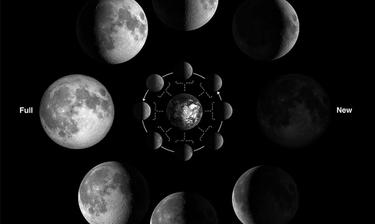
The Heavens
Phases of the Moon
By Carl J. Butz
•
April 4, 2024
Here is the sequence of the eight main Moon phases:
Read More

The Heavens
The Heavens
By Carl J. Butz
•
March 28, 2024
If a Meteorite Falls to Earth, Who Owns It?Source: New York Times/Andreas Forsberg/Swedish Museum of Natural HistoryLast week, this column asked if space contains threats to people on earth. A few days later, the Sunday edition of the New York Times carried a story from Sweden about a large, “fresh fall” meteorite (discovered after weeks of search in 2020 by a geologist who had set-up cameras to detect falling meteorites) becoming a legal issue when the owner of the land where the ancient chunk of iron rock came to rest claimed ownership.In 2022, the Uppsala District Court ruled in favor of the geologist deciding, “A newly fallen meteorite is not part of the property on which it landed.” Last Thursday, however, an appeals court in Stockholm ruled in favor of the land owner, saying Sweden’s long-standing concept of “Allemansratten” - the right of everyone to use nature, including the acts of hiking, biking, and camping on private property - does
Read More

The Heavens
The Heavens
By Carl J. Butz
•
March 7, 2024
PACE - A Unique and Useful SatellitePhoto credit: NASA (pace.oceansciences.org/mission.htm)While unbalanced moonlanders grabbed media attention last month, the successful launch of NASA’s PACE (Plankton, Aerosol, Cloud, ocean Ecosystem) satellite into low-earth, polar orbit on February 8th has failed to attract attention.PACE’s mission is multifaceted — to improve our understanding of the ocean’s global carbon cycle and ecosystem by measuring the ocean’s colors; to collect global observations of aerosol/cloud properties and reduce uncertainties in climate models for the Earth’s weather system; and, to improve our comprehension of the interaction between earth’s atmosphere and the ocean’s biologic and chemical cycles.To accomplish these assignments, the craft sports an Ocean Color Instrument (OCI) capable of measuring color from ultraviolet to shortwave infrared and two polarimeters for observing how the oscillation of sunlight within geom
Read More

The Heavens
The Heavens
By Carl J. Butz
•
February 29, 2024
Landing on the Moon Isn’t EasyThe Odysseus spacecraft took this “selfie” while passing over the near side of the moon, a short time before landing on its side. Photo Credit: Intuitive Machines - ReutersLast month, the Japanese space agency tested a moonlander designed to arrive at a precise location near the moon’s south pole. They hit their target, but the vehicle was traveling too fast to handle the sloping surface and SLIM (Smart Lander for Investigating Moon) landed upside down. Oh well, the agency said, we got to where we wanted to be. The craft wasn’t equipped with the equipment needed to do any practical discovery work.This month, Odyssey, the first lander sent to the moon by a private American company, Intuitive Machines (IM), apparently was not traveling quite vertically when it got to the moon’s surface (did it graze a rock?) and the vehicle landed on its side. This meant the craft’s antennae were not aiming directly at the earth and
Read More
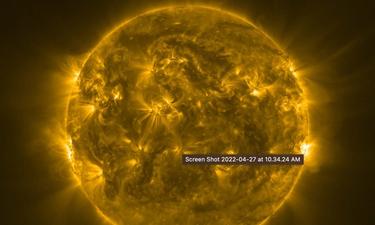
The Heavens
The Heavens
By Carl J. Butz
•
February 22, 2024
Another Solar Maximum is ComingImage credit: ESA & NASA / Solar Orbiter / EUI TeamThe Sun is a dynamic entity, going through a roughly 11-year cycle of increased and decreased activity. Currently the Sun is approaching the solar maximum period within the cycle, a time when the Sun is most likely to display brilliant flares, dark sunspots, loops of plasma, and swirls of super-hot gas. The European Space Agency’s Solar Orbiter spacecraft saw this kind of activity (pictured to the right) during a recent close approach to the Sun.According to a prediction made by NOAA’s Space Weather Prediction Center last December, the current cycle activity will occur sooner, increase more quickly, be more intense than their last prediction in 2019, and will peak somewhere between now and October 2024.As a result of the solar maximum, we on earth can expect increased interference with the electrical grid and radio reception, degraded GPS signals, increased orbital drag on satellites, and
Read More
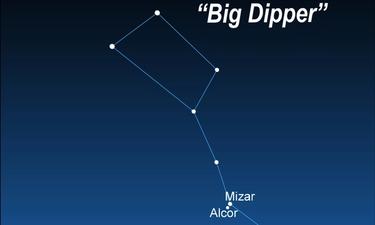
The Heavens
Night Sky
By Carl J. Butz
•
February 15, 2024
Mizar and Alcor in the Big DipperOn one of those, currently, rare winter evenings when the sky is cloudless, you can easily find the famous asterism we call the Big Dipper. When you do, find the star in the middle of the Dipper’s handle.Looking very closely, you’ll see 2 points of light. The larger point is named Mizar and its smaller companion is called Alcor. While these two stars look superb when viewed by a pair of binoculars, even people with poor eyesight should be able to discern both Mizar and Alcor in a dark sky.However, you would need to have a small telescope like the one used by an Italian astronomer who informed Galileo in 1617 that Mizar is a double star caused by a chance alignment of physically unrelated stars. This opinion was overruled in 1889 when a spectroscope revealed the brighter component of Mizar’s two stars consisted of two stars. Later, spectroscopic analysis of the dimmer component of Mizar’s two stars was also composed of two stars.
Read More
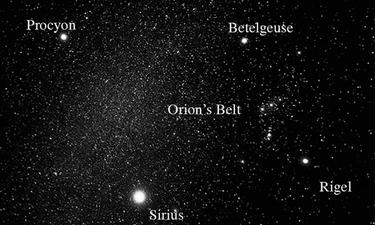
The Heavens
Night Sky
By Carl J. Butz
•
February 8, 2024
Procyon in Canis Minor (The Lesser Dog) and Sirius in Canis Major (The Greater Dog)This ground-based image was taken by Japanese amateur astronomer Akira Fujii and shows the constellations Orion, Canis Minor and Canis major.Credit: Akira Fujii Source: esahubble.orgProcyon, the 8th-brightest star in our sky, is one of the brilliant stars in the Winter Circle/Hexagon, an asterism discussed here a couple of weeks ago. However, Procyon is also the primary member of a small constellation, Canis Minor (The Lesser Dog), the 71st biggest of the 88 “official” constellations in the sky.As it happens, in ancient Greek mythology, the constellation Canis (dominated by the star Sirius) was formed when Zeus elevated the fastest of all dogs to assist Orion (“The Hunter”) with capturing “The Hare” (Lepus) at his feet. Roman mythology added a miniature dog, almost directly above Canis, having excellent endurance to the hunter’s mix. Thus, Canis Major and Ca
Read More